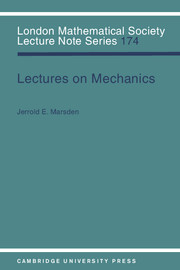
-
Select format
-
- Publisher:
- Cambridge University Press
- Publication date:
- 05 August 2012
- 30 April 1992
- ISBN:
- 9780511624001
- 9780521428446
- Dimensions:
- Weight & Pages:
- Dimensions:
- (228 x 152 mm)
- Weight & Pages:
- 0.387kg, 268 Pages
You may already have access via personal or institutional login
Book description
The use of geometric methods in classical mechanics has proven to be a fruitful exercise, with the results being of wide application to physics and engineering. Here Professor Marsden concentrates on these geometric aspects, and especially on symmetry techniques. The main points he covers are: the stability of relative equilibria, which is analyzed using the block diagonalization technique; geometric phases, studied using the reduction and reconstruction technique; and bifurcation of relative equilibria and chaos in mechanical systems. A unifying theme for these points is provided by reduction theory, the associated mechanical connection and techniques from dynamical systems. These methods can be applied to many control and stabilization situations, and this is illustrated using rigid bodies with internal rotors, and the use of geometric phases in mechanical systems. To illustrate the above ideas and the power of geometric arguments, the author studies a variety of specific systems, including the double spherical pendulum and the classical rotating water molecule. This book, based on the 1991 LMS Invited Lectures, will be valued by pure and applied mathematicians, physicists and engineers who work in geometry, nonlinear dynamics, mechanics, and robotics.
Reviews
"...centres around symmetry and symplectic quotients. Many examples are given illustrating the utility and relevance of symplectic quotients....readable and stimulating." Michael Atiyah, Bulletin of the American Mathematical Society
"...The virtue [of this book] is in the breadth, relevance, and complexity of the examples treated..." Mathematical Reviews
Contents
Metrics
Full text views
Full text views help Loading metrics...
Loading metrics...
* Views captured on Cambridge Core between #date#. This data will be updated every 24 hours.
Usage data cannot currently be displayed.
Accessibility standard: Unknown
Why this information is here
This section outlines the accessibility features of this content - including support for screen readers, full keyboard navigation and high-contrast display options. This may not be relevant for you.
Accessibility Information
Accessibility compliance for the PDF of this book is currently unknown and may be updated in the future.


